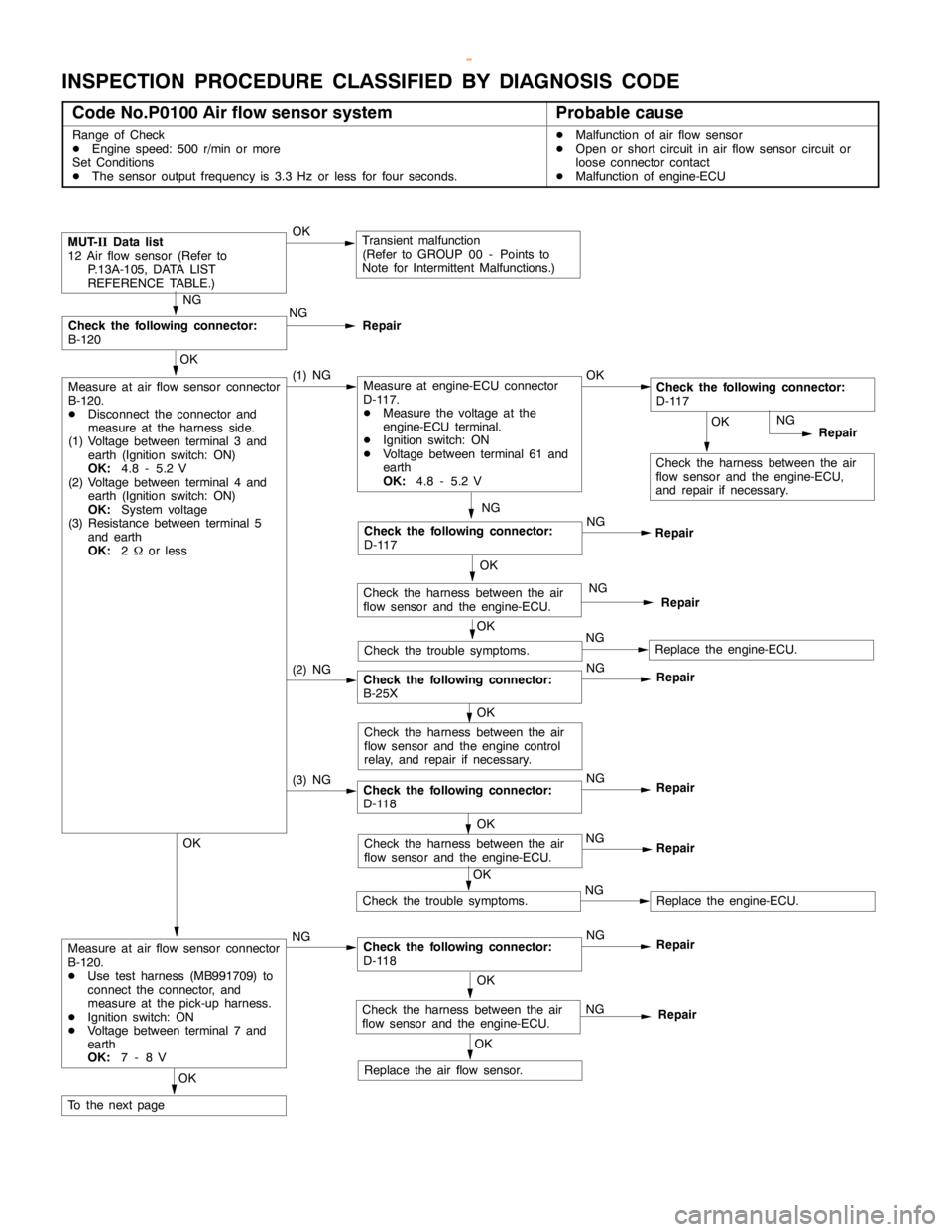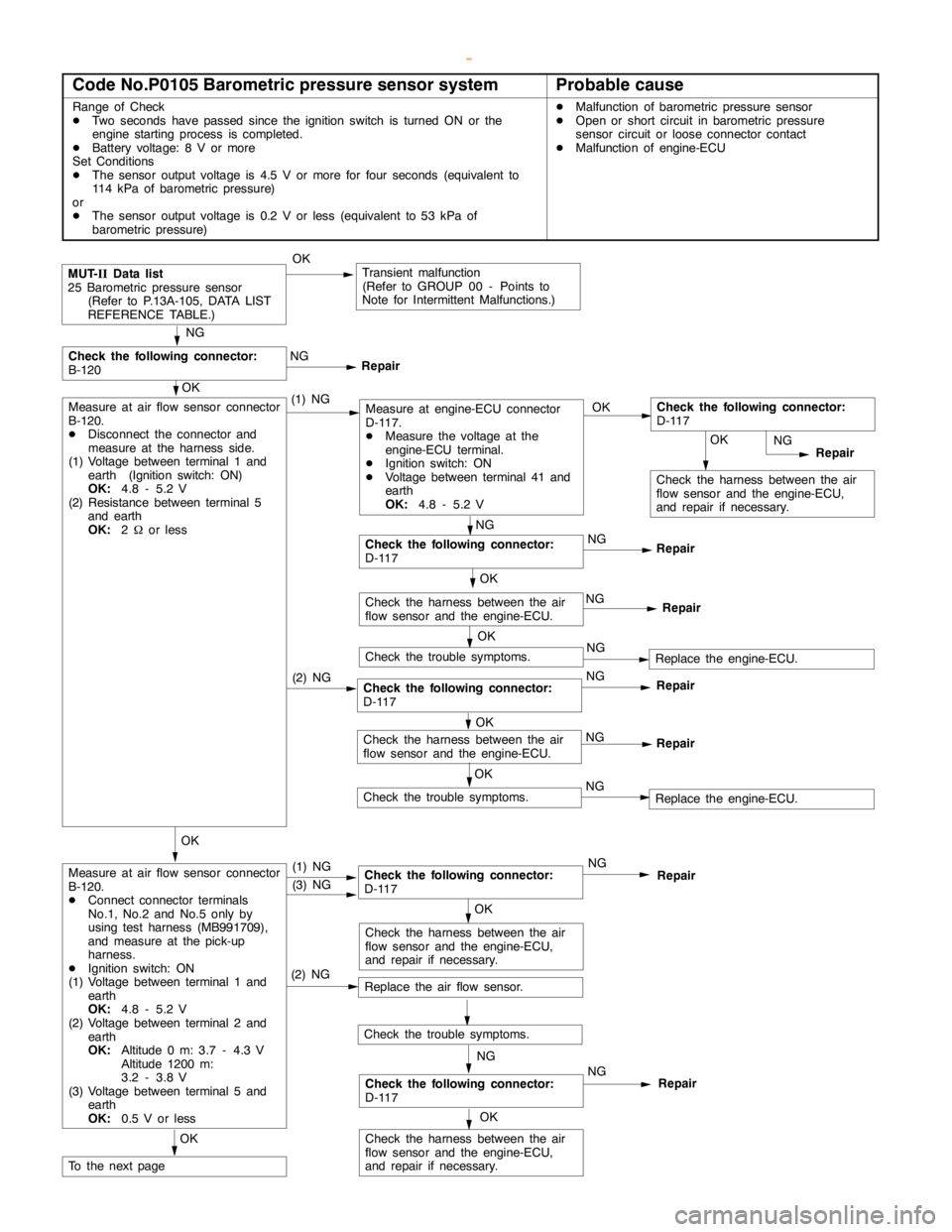ignition MITSUBISHI MONTERO 2000 Service Repair Manual
[x] Cancel search | Manufacturer: MITSUBISHI, Model Year: 2000, Model line: MONTERO, Model: MITSUBISHI MONTERO 2000Pages: 1839, PDF Size: 29.19 MB
Page 46 of 1839

3 MSB-00E00-505
3. Details:
Contents of Attachment are to be added to GROUP 00 (GENERAL).
PRECAUTIONS BEFORE SERVICE
LEARNING FUNCTION OF GDI ENGINE
1. Purpose
On the GDI engine equipped cars, when replacement of the ECU (for engine control) or resetting
of the battery* has been performed, an idle learning function of the ECU (for engine control) will
be required.
The idle learning function will be completed by running the engine at idle by the following procedure.
NOTE:
*: Disconnection of ECU (for engine control) battery backup power supply (disconnection of battery
terminals or ECU connectors)
2. Idle Learning Procedure
(1) Start the engine, and warm up the engine until its coolant temperature reaches 85°C or higher.
When the engine coolant temperature is 85°C or higher, you have only to turn the ignition
switch to the ON position.
(2) Turn the ignition switch to the LOCK (OFF) position, and stop the engine.
(3) After lapse of ten or more seconds, restart the engine.
(4) Run the engine at idle for ten minutes under the following conditions.
DTransmission: Neutral (P range for automatic transmission)
DAir conditioner and heater: Not operational
DEngine coolant temperature: 83°C or higher
(5) Stop the engine.
(6) Restart the engine, and run it at idle for ten minutes under the following condition.
DTransmission: Neutral (P range for automatic transmission)
DAir conditioner: Operational (Temperature set at “maximum cool”, fan at high speed, and
windows fully opened)
DEngine coolant temperature: 83°C or higher
(7) Repeat steps (5) and (6).
NOTE:
1) When the atmospheric temperature is 20°C or more and the air conditioner has continuously
been operated, step (7) may be omitted.
2) During idling operation of the engine in steps (4) and (6), when engine operation switches
from lean operation to stoichiometric operation, engine stall can occur. In this case, clean the
throttle body (throttle valve) thoroughly, and then repeat step (1) and the subsequent steps.
www.WorkshopManuals.co.uk
Purchased from www.WorkshopManuals.co.uk
Page 56 of 1839

11A-2
ENGINE <6G7>
CONTENTS
GENERAL INFORMATION 3..................
SERVICE SPECIFICATIONS 3.................
SEALANT 4..................................
SPECIAL TOOLS 4..........................
ON-VEHICLE SERVICE 6.....................
Drive Belt Tension Check and Adjustment 6......
Auto-tensioner Check 6.........................
Ignition Timing Check 6........................
Idle Speed Check 7............................
Idle Mixture Check 8...........................Compression Pressure Check 9.................
Intake Manifold Vacuum Check 10...............
Lash Adjuster Check 10........................
OIL PAN AND OIL SCREEN 13..............
TIMING BELT 15............................
CRANKSHAFT OIL SEAL 23.................
CAMSHAFT OIL SEAL 25...................
CYLINDER HEAD GASKET 27...............
ENGINE ASSEMBLY 30.....................
www.WorkshopManuals.co.uk
Purchased from www.WorkshopManuals.co.uk
Page 57 of 1839

ENGINE <6G7> -General Information/Service Specifications11A-3
GENERAL INFORMATION
Items6G74-GDI
Total displacement ml3,497
Bore´Stroke mm93´85.8
Compression ratio10.4
Combustion chamberPentroof + ball-in-piston
Camshaft arrangementDOHC
Number of valveIntake12
Exhaust12
Valve timingIntakeOpeningBTDC 8_
ClosingABDC 56_
ExhaustOpeningBBDC 48_
ClosingATDC 16_
Fuel systemElectronically controlled multipoint fuel injection
Rocker armRoller type
Auto-lash adjusterEquipped
SERVICE SPECIFICATIONS
ItemsStandard valueLimit
Basic ignition timing5_BTDC±3_-
Ignition timingApprox. 20_BTDC*1-
Idle speed r/min600±100*1-
CO contents %0.5 or less-
HC contents ppm100 or less-
Compression pressure (at engine speed of 280 r/min) kPa1,275980
Compression pressure difference of all cylinders kPa-Max. 98
Intake manifold vacuum kPa-Min. 56*2
Auto tensioner rod depth (mm)Within 1-
Timing belt tension torque N×m4.4-
Auto-tensioner rod protrusion amount mm3.8 - 5.0-
NOTE
*1: Indicates the value measured within 4 minutes since the engine was started.
*2: Indicates the value when more than 4 minutes have passed since the engine was started.
www.WorkshopManuals.co.uk
Purchased from www.WorkshopManuals.co.uk
Page 217 of 1839

GDI -General Information13A-3
GENERAL INFORMATION
The Gasoline Direct Injection System consists
of sensors which detect the engine conditions,
the engine-ECU
which controls the system based on
signals from these sensors, and actuators
which operate under the control of the
engine-ECU
carries out activities such as fuel injection
control, idle speed control and ignition timing
control. In addition, the engine-ECU
engine-A/T-ECU is equipped with several
diagnosis modes which simplify troubleshooting
when a problem develops.
FUEL INJECTION CONTROL
The injector drive times and injector timing are
controlled so that the optimum air/fuel mixture
is supplied to the engine to correspond to the
continually-changing engine operation condi-
tions.
A single injector for each cylinder is mounted
at the cylinder head. The fuel is sent under
pressure from the fuel tank to the fuel pressure
regulator (low pressure) by the fuel pump (low
pressure). The pressure is regulated by the
fuel pressure regulator (low pressure) and the
fuel regulated is then sent to the fuel pump
(high pressure). The fuel under increased
pressure generated by the fuel pump (high
pressure) is then regulated by the fuel pressure
regulator (high pressure) and is then distributed
to each of the injectors via the delivery pipes.Fuel injection is normally carried out once for
each cylinder for every two rotations of the
crankshaft. The firing order is 1-2-3-4-5-6. This
is called sequential fuel injection.
When the engine is cold or under a severe
load, the “open-loop” control keeps the air/fuel
ratio at a richer than usual level to maintain
driveability. When the engine is under low or
medium loads, the air/fuel ratio becomes leaner
to reduce fuel consumption. When the engine
is running at medium or high loads after having
warmed up, the “closed-loop” control uses the
signal from the oxygen sensor to keep the
air/fuel ratio at the optimum theoretical level.
THROTTLE VALVE OPENING ANGLE CONTROL
This system controls throttle valve opening
angle electronically. The engine-ECU
or engine-A/T-ECU determines how
deeply the accelerator pedal is depressed by
means of the accelerator position sensor (APS).
Then the engine-ECU
throttle valve opening angle to the throttle valve
controller. The throttle valve control servo
operates the throttle valve so that it reaches
the target opening angle.
IDLE SPEED CONTROL
This system maintains engine idle speed at
a predetermined condition by controlling the
air flow that passes through the throttle valve
according to engine idling condition and engine
loads at idling.
The engine-ECU
operates the throttle valve control servoso that engine speed is maintained within a
map value. The map value is predetermined
according to engine coolant temperature and
air-conditioning load.
IGNITION TIMING CONTROL
The power transistor located in the ignition
primary circuit turns ON and OFF to control
the primary current flow to the ignition coil. This
controls the ignition timing in order to provide
the optimum ignition timing with respect to the
engine operating conditions. The ignition timingis determined by the engine-ECU
engine-A/T-ECU from the engine speed,
intake air volume, engine coolant temperature,
atmospheric pressure and injection timing
(intake stroke or compression stroke).
www.WorkshopManuals.co.uk
Purchased from www.WorkshopManuals.co.uk
Page 224 of 1839

GDI -Troubleshooting
Code No. Diagnosis item
P0206No.6 injector system
P0220LAccelerator pedal position sensor (1st channel) system
P0225LThrottle position sensor (2nd channel) system
P0300LIgnition coil (power transistor) system
P0301No.1 cylinder misfire detected.
P0302No.2 cylinder misfire detected.
P0303No.3 cylinder misfire detected.
P0304No.4 cylinder misfire detected.
P0305No.5 cylinder misfire detected.
P0306No.6 cylinder misfire detected.
P0335Crank angle sensor system
P0340Camshaft position sensor system
P0403EGR valve system
P0420Catalyst malfunction
P0443Purge control solenoid valve system
P1200Injector driver system
P1220LElectronic-controlled throttle valve system
P1221LThrottle valve position feedback system
P1222LThrottle control servo system
P1223LCommunication line system with throttle valve controller
P1225LAccelerator pedal position sensor (2nd channel) system
P1226LThrottle valve controller system
NOTE
1. If the engine warning lamp illuminates because of a malfunction of the engine-ECU, communication
between MUT-
IIand the engine-ECU is impossible. In this case, the diagnosis code cannot be read.
2. After the engine-ECU has detected a malfunction, the engine warning lamp illuminates when the
engine is next turned on and the same malfunction is re-detected. However, for items marked with
a“
L” in the diagnosis code number column, the engine warning lamp illuminates only on the first
detection of the malfunction.
If diagnosis code P0120, P0220, P0225 or P1225 is set, the engine warning lamp will flash. If the
1st and 2nd channels of the throttle postion sensor or the acccelerator pedal position sensor fail
at the same time, the engine warning lamp will also flash.
3. After the engine warning lamp illuminates, it will be switched off under the following conditions.
(1) When the engine-ECU monitored the power train malfunction three times* and met set condition
requirements, it detected no malfunction.
*: In this case, “one time” indicates from engine start to stop.
(2) For misfiring malfunction, when driving conditions (engine speed, engine coolant temperature,
etc.) are similar to those when the malfunction was first recorded.
www.WorkshopManuals.co.uk
Purchased from www.WorkshopManuals.co.uk
Page 225 of 1839

GDI -Troubleshooting
4. Sensor 1 indicates the sensor mounted at a position closest to the engine, and sensor 2 indicates
the sensor mounted at the position second closest to the engine.
METHOD OF READING AND ERASING DIAGNOSIS
CODES
Refer to GROUP 00 - How to Use Troubleshooting/Inspection
Service Points.
DIAGNOSIS USING DIAGNOSIS 2 MODE
1. Switch the diagnosis mode of the engine control unit
to DIAGNOSIS 2 mode using the MUT-II.
2. Carry out a road test.
3. Take a reading of the diagnosis code and repair the
problem location.
4. Turn the ignition switch to OFF and then back to ON
again.
NOTE
By turning the ignition switch to OFF, the ENGINE-ECU will
switch the diagnosis mode from DIAGNOSIS 2 mode to
DIAGNOSIS 1 mode.
5. Erase the diagnosis codes.
INSPECTION USING MUT-II
DATA LIST AND
ACTUATOR TESTING
1. Carry out inspection by means of the data list and the
actuator test function. If there is an abnormality, check
and repair the chassis harnesses and components.
2. After repairing, re-check using the MUT-IIand check that
the abnormal input and output have returned to normal
as a result of the repairs.
3. Erase the diagnosis code memory.
4. Remove the MUT-II, and then start the engine again and
carry out a road test to confirm that the problem has
disappeared.
www.WorkshopManuals.co.uk
Purchased from www.WorkshopManuals.co.uk
Page 227 of 1839

GDI -Troubleshooting
FAIL-SAFE FUNCTION REFERENCE TABLE
When the main sensor malfunctions are detected by the diagnosis function, the vehicle is controlled
by means of the pre-set control logic to maintain safe conditions for driving.
Malfunctioning itemControl contents during malfunction
Air flow sensor1. Suspends lean burn operation.
2. Uses the throttle position sensor signal and engine speed signal (crank angle
sensor signal) to take reading of the basic injector drive time and basic ignition
timing from the pre-set mapping.
Intake air temperature sensorControls as if the intake air temperature is 25_
C.
Throttle position sensor (2nd
channel)1. Suspends lean burn operation.
2. Controls the throttle opening angle feedback (half as much as the opening
rate in the normal condition) by using signals from the throttle position sensor
(1st channel). However, this controlling system is not applied if the throttle
position sensor (1st channel) and throttle position sensor (2nd channel)
combination output voltage is outside 4 - 6 V.
3. Refrains from controlling the throttle opening angle feedback if the throttle
position sensor (1st channel) is also defective.
Engine coolant temperature
sensorControls as if the engine coolant temperature is 80_
C. (Moreover, the control system
is working until the ignition switch is turned OFF if the sensor signal returns to normal.)
Camshaft position sensorCuts the fuel supply once a malfunction is detected. (Only when there has been
no occasion of detecting No.1 cylinder top dead centre after the ignition switch
is turned ON.)
Vehicle speed sensor1. Suspends lean burn operation. However, the control is cancelled as a certain
time passes by with the engine speed of 1,500 r/min or more.
2. Suspends lean burn operation during the engine idling.
Barometric pressure sensorControls as if the barometric pressure is 101 kPa.
Detonation sensorFixes the ignition timing as that for standard petrol.
Injector1. Suspends lean burn operation.
2. Suspends the exhaust gas recirculation.
Ignition coil (incorporating pow-
er transistor)1. Suspends lean burn operation.
2. Cuts off the fuel supply to cylinders with an abnormal ignition signal.
Fuel pressure sensor1. Controls as if the fuel pressure is 5MPa.
2
. Suspends fuel injection. (when the low pressure is detected and the engine
speed is more than 3,000r/min)
Alternator FR terminalRefrains from controlling to suppress the alternator output to electrical load.
(Operated as a normal alternator)
Accelerator pedal position sen-
sor (2nd channel)1. Suspends lean burn operation.
2. Controls the throttle valve position by using signals from the accelerator pedal
position sensor (1st channel). (However, the control system is not applicable
if the difference from the accelerator pedal position sensor (1st channel) output
voltage is 1.0 V or higher.)
3
. Suspends the electronic controlled throttle valve system if accelerator pedal
position sensor (1st channel) is also defective.
www.WorkshopManuals.co.uk
Purchased from www.WorkshopManuals.co.uk
Page 229 of 1839

GDI -Troubleshooting
INSPECTION CHART FOR DIAGNOSIS CODES
Code No.Diagnosis itemReference page
P0100Air flow sensor system13A-17
P0105Barometric pressure sensor system13A-19
P0110Intake air temperature sensor system13A-21
P0115Engine coolant temperature sensor system13A-22
P0120LThrottle position sensor (1st channel) system13A-25
P0125Feedback system13A-27
P0130Oxygen sensor (front) system
P0135Oxygen sensor heater (front) system
P0136Oxygen sensor (rear) system
P0141Oxygen sensor heater (rear) system
P0170Abnormal fuel system13A-34
P0190LAbnormal fuel pressure13A-36
P0201No.1 injector system13A-38
P0202No.2 injector system13A-40
P0203No.3 injector system13A-42
P0204No.4 injector system13A-44
P0205No.5 injector system13A-46
P0206No.6 injector system13A-48
P0220LAccelerator pedal position sensor (1st channel) system13A-50
P0225LThrottle position sensor (2nd channel) system13A-52
P0300LIgnition coil (power transistor) system13A-53
P0301No.1 cylinder misfire detected.13A-55
P0302No.2 cylinder misfire detected.13A-55
P0303No.3 cylinder misfire detected.13A-55
P0304No.4 cylinder misfire detected.13A-55
P0305No.5 cylinder misfire detected.13A-55
P0306No.6 cylinder misfire detected.13A-55
P0325Detonation sensor system13A-56
P0335Crank angle sensor system13A-56
P0340Camshaft position sensor system13A-58
P0403EGR valve system13A-60
P0420Catalyst malfunction13A-61
www.WorkshopManuals.co.uk
Purchased from www.WorkshopManuals.co.uk
Page 231 of 1839

GDI -Troubleshooting
INSPECTION PROCEDURE CLASSIFIED BY DIAGNOSIS CODE
Code No.P0100 Air flow sensor systemProbable cause
Range of Check
DEngine speed: 500 r/min or more
Set Conditions
DThe sensor output frequency is 3.3 Hz or less for four seconds.DMalfunction of air flow sensor
DOpen or short circuit in air flow sensor circuit or
loose connector contact
DMalfunction of engine-ECU
(3) NGCheck the following connector:
D-118NG
Repair
(2) NGCheck the following connector:
B-25XNG
Repair
OK
Check the harness between the air
flow sensor and the engine-ECU,
and repair if necessary.
MUT-
IIData list
12 Air flow sensor (Refer to
P.13A-105, DATA LIST
REFERENCE TABLE.)OKTransient malfunction
(Refer to GROUP 00 - Points to
Note for Intermittent Malfunctions.)
NG
Check the following connector:
B-120NG
Repair
OK
Measure at air flow sensor connector
B-120.
DDisconnect the connector and
measure at the harness side.
(1) Voltage between terminal 3 and
earth (Ignition switch: ON)
OK:
4.8 - 5.2 V
(2) Voltage between terminal 4 and
earth (Ignition switch: ON)
OK:
System voltage
(3) Resistance between terminal 5
and earth
OK:
2Wor less(1) NGMeasure at engine-ECU connector
D-117.
DMeasure the voltage at the
engine-ECU terminal.
DIgnition switch: ON
DVoltage between terminal 61 and
earth
OK:
4.8 - 5.2 VOKCheck the following connector:
D-117
NG
Repair
OK
Replace the air flow sensor.
NG
Check the following connector:
D-117NG
Repair
OK
Check the harness between the air
flow sensor and the engine-ECU.NG
Repair
OK
Check the trouble symptoms.NGReplace the engine-ECU.
OK
Check the harness between the air
flow sensor and theengine control
relay, and repair if necessary.
OK
Check the harness between the air
flow sensor and the engine-ECU.NG
Repair
OK
Check the trouble symptoms.NGReplace the engine-ECU.
OK
Measure at air flow sensor connector
B-120.
DUse test harness (MB991709) to
connect the connector, and
measure at the pick-up harness.
DIgnition switch: ON
DVoltage between terminal 7 and
earth
OK:
7-8VNGCheck the following connector:
D-118NG
Repair
OK
Check the harness between the air
flow sensor and the engine-ECU.NG
Repair
OK
To the nextpage
www.WorkshopManuals.co.uk
Purchased from www.WorkshopManuals.co.uk
Page 233 of 1839

GDI -Troubleshooting
Code No.P0105 Barometric pressure sensor systemProbable cause
Range of Check
DTwo seconds have passed since the ignition switch is turned ON or the
engine startingprocess is completed.
DBattery voltage: 8 V or more
Set Conditions
DThe sensor output voltage is 4.5 V or more for four seconds (equivalent to
114 kPa of barometric pressure)
or
DThe sensor output voltage is 0.2 V or less (equivalent to 53 kPa of
barometric pressure)DMalfunction of barometric pressure sensor
DOpen or short circuit in barometric pressure
sensor circuit or loose connector contact
DMalfunction of engine-ECU
(2) NGCheck the following connector:
D-117NG
Repair
OK
Check the harness between the air
flow sensor and the engine-ECU,
and repair if necessary.
MUT-
IIData list
25 Barometric pressure sensor
(Refer to P.13A-105, DATA LIST
REFERENCE TABLE.)OKTransient malfunction
(Refer to GROUP 00 - Points to
Note for Intermittent Malfunctions.)
NG
NG
Repair
OK
Measure at air flow sensor connector
B-120.
DDisconnect the connector and
measure at the harness side.
(1) Voltage between terminal 1 and
earth (Ignition switch: ON)
OK:
4.8 - 5.2 V
(2) Resistance between terminal 5
and earth
OK:
2Wor less(1) NGMeasure at engine-ECU connector
D-117.
DMeasure the voltage at the
engine-ECU terminal.
DIgnition switch: ON
DVoltage between terminal 41 and
earth
OK:
4.8 - 5.2 VOKCheck the following connector:
D-117
NG
Repair
NG
Check the following connector:
D-117NG
Repair
OK
Check the harness between the air
flow sensor and the engine-ECU.NG
Repair
OK
Check the trouble symptoms.NGReplace the engine-ECU.
OK
Measure at air flow sensor connector
B-120.
DConnect connector terminals
No.1, No.2 and No.5 only by
using test harness (MB991709),
and measure at the pick-up
harness.
DIgnition switch: ON
(1) Voltage between terminal 1 and
earth
OK:
4.8 - 5.2 V
(2) Voltage between terminal 2 and
earth
OK:
Altitude 0 m: 3.7 - 4.3 V
Altitude 1200 m:
3.2 - 3.8 V
(3) Voltage between terminal 5 and
earth
OK:
0.5 V or less(1) NGCheck the following connector:
D-117NG
Repair
OK
Check the harness between the air
flow sensor and the engine-ECU,
and repair if necessary.
OK
To the nextpage(3) NG
(2) NG
Replace the air flow sensor.
NG
Check the following connector:
D-117NG
Repair
OK
Check the harness between the air
flow sensor and the engine-ECU,
and repair if necessary.
OK
Check the harness between the air
flow sensor and the engine-ECU.NG
Repair
OK
Check the trouble symptoms.NGReplace the engine-ECU.
Check the following connector:
B-120
Check the trouble symptoms.
www.WorkshopManuals.co.uk
Purchased from www.WorkshopManuals.co.uk